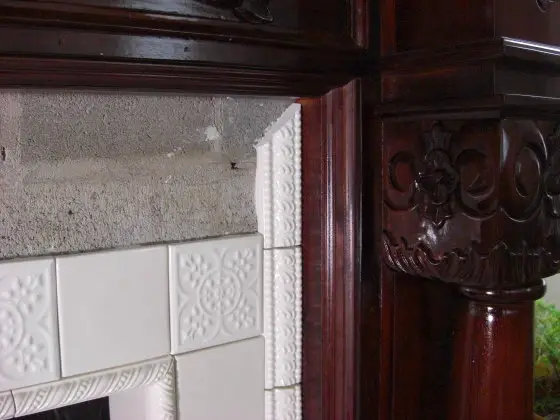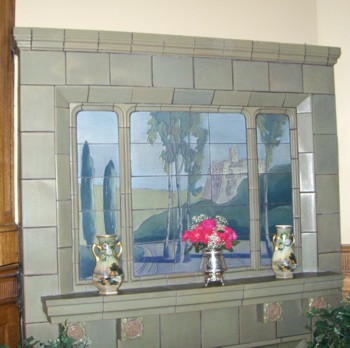Ceramic Fireplace Tile

This ceramic fireplace tile is new, but it looks like the fireplace could be over one-hundred-years old. PHOTO CREDIT: Tim Carter
DEAR TIM: I grew up in an old home that had ceramic fireplace tile. I’d love to recreate that look in a new home I’m getting ready to build. What’s it take to install a ceramic tile fireplace that will not be harmed by the heat of the fire? Where’s the best place to look for ceramic tile fireplace designs? I went to several home centers and was rapidly disappointed. There has to be vintage tile out there that will allow visitors to think my tile is from another century. Martha V., Gloucester MA
DEAR MARTHA: Oh, I know exactly what you’re talking about. My childhood home didn’t have a ceramic-tile surround, it had brick. But many of the older homes I visited and worked in early in my remodeling and building career had magnificent ceramic tile surrounds. In fact, in Cincinnati, OH, there was a famous tile company, Rookwood Tile, that made entire ceramic-tile mantles and surrounds. (See the photo below left.) There are thousands of these fireplaces still in service in the original suburbs of Cincinnati that sprouted up on the seven hills above the inner city.
The great news for you is that you absolutely will be able to purchase new ceramic tile that looks like it was made 100 or more years ago. There are several manufacturers that specialize in highly decorative tile that can be used for fireplaces. In fact, some of it is so custom, it’s hand-painted and glazed when you order it. It’s possible they can even do a custom color for you if that’s what you need to have.
As you discovered, you’ll never find this tile at a home center. You have to work a little bit and go to a specialty tile store that not only sells just tile and other stone products, but also sells tile made by hundreds of small obscure companies that make every imaginable tile you can think of.
The tile you see at a big box home center, in my opinion, represents perhaps 0.001 percent of all the tile that’s available to you if you just find the right stores. Many of these do sell online. Keep in mind that no one store can stock, or even display, all the tile that’s available. It pays to visit as many specialty tile stores as you can find near you.

An example of a Rookwood Fireplace mantle and surround in the Wiedemann Hill Mansion. PHOTO: Roger R Henthorn
Just recently, I did the same thing you’re going to do. I installed ceramic tile around a fireplace in my home. It was a tile my wife discovered in one visit to the largest tile store in our city. This particular tile has all sorts of different trim tiles that look like door and window trim moldings, and they also have all sorts of tile trim strips that allow you to create any number of designs by intermixing the different trim tiles with the flat and decorative field tiles.
The challenge in working with tile like this and a fireplace surround is making sure you calculate how to get the tile to fit between the mantle and the fireplace opening. It took me an hour or more to determine how I was going to make this happen. Even with that amount of work, I still ended up with a pesky cut tile in the center of the surround. If you want the tile to be installed with no cuts, you have to buy the tile before you build your home and lay it out carefully on a piece of plywood so that the mason who constructs your fireplace can see the exact width and height you need for the fireplace opening.
Keep in mind that the tile must be installed with cement-based thinset mortar. You shouldn’t use an organic mastic to apply this tile. The heat from the fire can cause this mastic to fail when used on the tiles that are closest to the fire. Thinset mortar is easy to work with, and only mix up enough that you can use in 45 minutes or less.
The mason who constructs your fireplace must be very skilled. The surface of the concrete block used to build the rough fireplace needs to be smooth and in the same plane. This means each concrete block must not tilt inwards or outwards as he stacks them one on top of one another. A wavy surface will cause you grief as you try to install the tile.
To get the strongest bond possible, make sure the surface of the concrete block is free of all dust. You should also slightly dampen it just before you apply the thinset mortar. An old squirt bottle works well for this. I also urge you to dampen the back of the ceramic tile before you place it in the fresh thinset. This water in the concrete block and tile will slow the loss of water from the thinset. This allows the thinset mortar to attain the highest amount of strength so that the tiles never pop off the concrete block.
Getting the tile spacing to work out with some mantles can be a challenge. You may have to add additional trim lumber to the mantle to achieve proper width and height so the tile can be installed with no or minimal cuts.
In my case, I had not only had to add trim lumber, but I also had to add extra mortar to the sides of my rough fireplace opening. When the concrete block was installed, we unfortunately didn’t know what tile we were going to use. To get the spacing correct, I installed the mantle then made a plywood template that was the exact width of the face tile that created the surround. I then added Portland cement mortar to the concrete block so it was even with this plywood form. It worked perfectly creating the exact width so that a full field tile and a trim tile on either side of it could be installed with no cuts.
Column 813